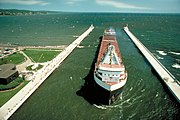Duluth Ship Canal
| Duluth Ship Canal | |
|---|---|

Unidentified laker entering the Duluth Ship Canal from the lake. The two entrance lights can be seen at the end of the piers, while the museum building is at the extreme left.
|
|
| Specifications | |
| Locks | none |
| Status | Open |
| History | |
| Original owner | US Federal Government |
| Construction began | 1870 |
| Date completed | 1871 |
The Duluth Ship Canal is an artificial channel cut through Minnesota Point, providing direct access to Duluth harbor from Lake Superior. Begun privately in 1871, it was put under federal supervision and maintenance several years later. It is still an important component of the harbor facilities.
In its current configuration, the channel is defined by a pair of breakwaters 1,720 feet (520 m) long and 300 feet (91 m) apart, constructed of concrete set on timber and stone . The channel is maintained at 245 feet (75 m) wide and 28 feet (8.5 m) LWD, allowing passage of ocean-going ships. Three lighthouses are placed on the sides of the channel: the Duluth North Pier Light and the Duluth South Breakwater Outer Light mark the lake ends of the channel, while the Duluth South Breakwater Inner Light functions with the south breakwater light as a range light. At the harbor end, the channel is straddled by the Aerial Lift Bridge which connects Minnesota Point to the rest of the city. On the north side, there is a building housing the local Corps of Engineers administration, as well as the Lake Superior Maritime Visitor Center. There are no locks; most ships transit the channel under their own power, though tug service is available in case of adverse weather. Around a thousand vessels a year ship from the Duluth–Superior port.
The construction of the first locks on the St. Marys River in 1855 allowed for navigation between the lakes, and Superior Bay presented itself as an attractive harbor. From the point of view of Duluth residents, however, arrangements were less than satisfactory, as ships from that city had to pass Superior, Wisconsin on the way to the lake, as the only natural outlet was between Minnesota Point and Wisconsin Point at the far end of the bay. Also, while sheltered, the bay was not naturally as deep as was desirable, and the channel was convoluted. In 1865 a harbor was constructed outside the bay using a breakwater, and this was gradually improved over the next several years. A storm in 1871 destroyed the structure, and though it was rebuilt the next year, it was abandoned in 1878 due to ongoing ice and storm damage.
...
Wikipedia
